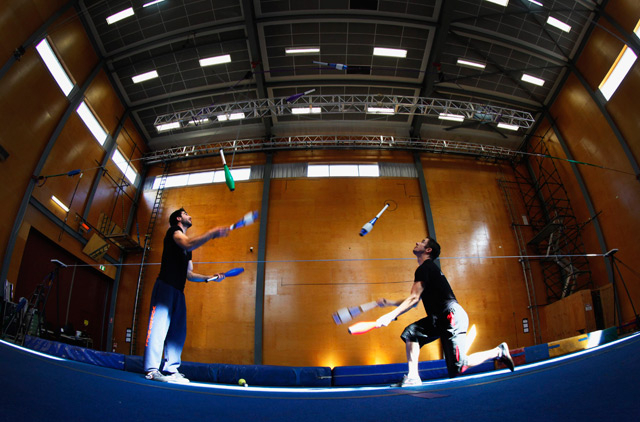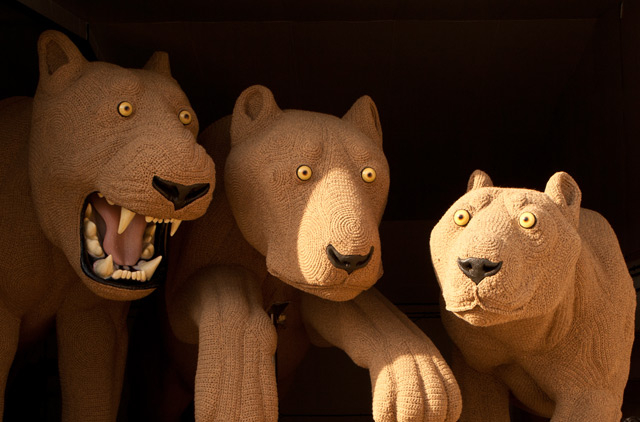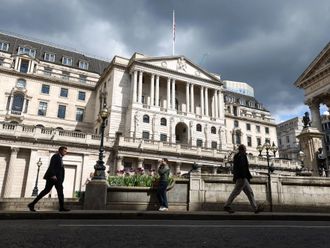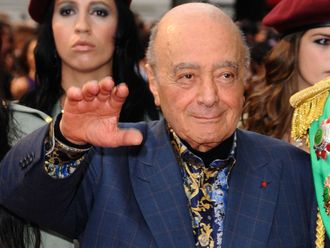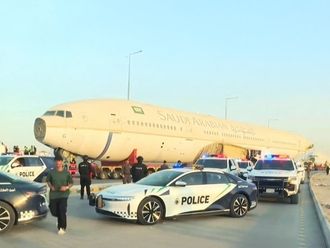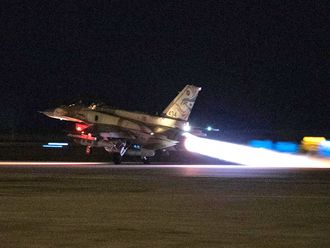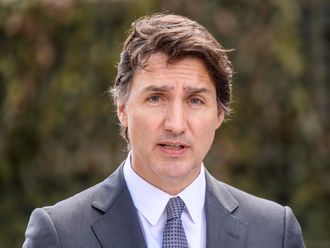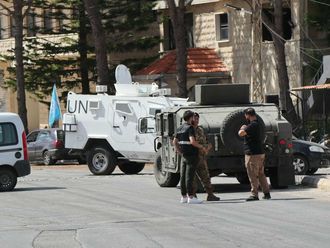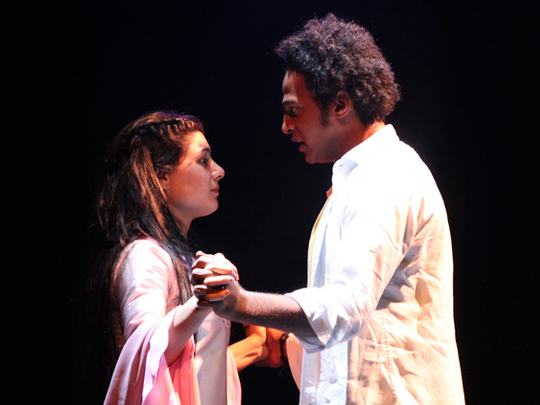
On July 27 the bells will ring out across the United Kingdom. Well, that is the idea. To launch the Olympic and Paralympic Games, a new work by Turner Prize-winning artist Martin Creed, prosaically entitled <Work No. 1197>, envisages that any bell — church, bicycle or door — will be rung hard and fast for three minutes.
Those who cannot find anything to ding or to dong can download a ringtone from Creed’s mobile phone so they won’t only be joining the party but will also own an original work of art.
And then they are off.
It is not just the Games that will bring the millions flocking to London — the celebrations around the Queen’s 60th Jubilee will have her loyal subjects out in droves. But there is more; a Cultural Olympiad that brings together a surfeit of arts and a roll call of A-listers including musicians Damon Albarn, Gustavo Dudamel, Baaba Maal and Sir Simon Rattle, actors Jude Law, Mark Rylance and artists Tracey Emin, Damien Hirst and Yoko Ono. Add an infinite variety of William Shakespeare — more than 70 productions of his plays — and, er, a road show involving a pride of crotcheted lions, and this is a marathon summer for the arts lover.
The Olympiad was actually launched in 2008 to collective groans of indifference from public and critics for its “esoteric luvvieness”, as one commentator put it, but the project has been given a re-boot as the London 2012 Festival and is to be launched on June 21. It includes many events that were already planned — the Proms have been going for 115 years, for example — and don’t be fooled by the London part of the re-brand — the events encompass the entire country.
Still, however you look at it — or label it — as Festival director Ruth Mackenzie said: “There may not be something for everyone but everyone will find something.”
What most visitors will find is the <ArcelorMittal Orbit>, designed by Anish Kapoor and funded by steel magnate Lakshmi Mittal. Slap bang in the Olympic park, this towering piece of public art looms over the neighbouring stadia as it twists and wriggles its rusty-red way 115 metres upward to an observation platform. As an enthusiastic London Mayor, Boris Johnson, said: “What better calling card for London 2012 than a piece of truly spectacular modern British art to drive visitors to east London in perpetuity.”
And, as a classic scholar, he added, rather obscurely: “It would have boggled the minds of the Romans.”
It has boggled the minds of most Brits. The sculpture is the tallest of its kind in the UK and will accommodate up to 5,000 visitors a day who will pay £15 (Dh86) to take the lift to the top. It looks like two or three helter skelters have been dropped from a great height and died in tangled heaps like those monsters from <War of the Worlds>, whose metallic might was destroyed by earthly bacteria. Still, as Kapoor said, somewhat defiantly, no one liked the Eiffel Tower when it was first built.
Damien Hirst will continue to boggle and beguile the crowds at Tate Modern with his retrospective as they clamour to decide whether he represents “Moral vacuity and rancid opportunism”(<The Daily Mail> newspaper) or if he really is “ground-breaking”(<The Times>).
Tate Modern is opening the former Bankside Power Station’s oil tanks — enormous circular spaces 30 metres across and 7 metres high — to make it the world’s biggest venue for what the gallery insists is the increasing demand for performance art. Open for 15 weeks from July 18, its highlights will include performances by choreographer Anne Teresa de Keermaeker and video and performance artist Sung Hwan Kim. Next door, Tino Sehgal, who specialises in works which involve encounters with people — he staged <The Kiss> in New York’s Guggenheim two years ago in which a couple embraced in slow-motion — is to prevail over the wide, open spaces of the Turbine Hall.
It is a far remove from Buckingham Palace where the Queen is making one of several regal contributions to the gaiety of the nation.
Leonardo da Vinci’s extraordinary studies of the human body which are among the Royal Collection’s greatest treasures are on show at Buckingham Palace to unanimous acclaim. The drawings show the complex evolution of Leonardo’s thinking on anatomy from his first works during the 1480s to his prescient studies of the heart between 1511-1513.
<Royal River: Power, Pageantry and the Thames> at the Greenwich Maritime is a sumptuous celebration of the Thames as the site for the pageantry of coronations, processions and other royal events and 100 of her art works, including two of her 50 Canalettos, are to be displayed at the Palace of Holyroodhouse, Edinburgh. Sixty photographs of The Queen, including the work by the press over the past six decades, will be on show at Windsor Castle and the National Portrait Gallery has mounted 60 portraits by such as Cecil Beaton, Pietro Annigoni and Andy Warhol.
As for the other great British institution — Shakespeare — the largest celebration of the playwright has been produced by the Royal Shakespeare Company with thousands of artists from around the world who will have taken take part in nearly 70 productions. Every play is performed in a different language — including <The Comedy of Errors> by the Afghanistan Roy-e-Sabs theatre, which was reported in the <Gulf News> recently. A production entitled <Rome and Juliet in Baghdad> by the Iraqi Theatre Company has a second outing (after appearing at Stratford) at the Riverside Studios in West London on June 28.
Director Monadhil Daood says: “<Romeo and Juliet> feels like the right play for Iraqi audiences at this time. I discussed my choice with many Iraqi writers and playwrights, who all agreed. We are living in a time of conflict and violence between communities in Iraq. The audience will see their own reality in front of them on stage. It may shock them.
“The truth is the same whether in Baghdad or London, and the best theatre speaks directly from one heart to another. Our play is about how to love and hate and live and die. And we hope that if we die, we die of love.”
The director admits to changes to the original. Instead of feuding Capulets and Montagues we witness the schism between Sunni and Shiite. The dialogue is sprinkled with references to the shooting of 17 civilians by the Blackwater military contractors, Iran and the American reconstruction effort.
“The importance of Shakespeare does not lie in the story itself, but in the way the events of the story are interpreted and presented,” Daood says. “I took my cue from Shakespeare in my own approach. We are creating a piece of theatre which reflects the modern world but which is rooted in Iraqi ritual. I believe that ritual is the soul of theatre.
“It would probably be more straightforward to translate Shakespeare’s play into formal Arabic, but our version is not a direct translation and is written entirely in colloquial Iraqi dialect. Our translator — himself a poet and filmmaker who trained in London — has joked despairingly about the impossible task of translating some of these Iraqi phrases and images directly into English. So we hope it will make sense to English audiences.”
The World Shakespeare Festival is often dazzling and invariably daring but like so many events under the Olympiad umbrella it has no particular link to the Games. The British Museum, with its unerring ability to bring the past to the present, has an exhibition, <The Horse: Ancient Arabia to the Modern World>, which examines the animal’s central role in society; in peace and war, in mythology and literature, particularly in the Middle East. Worth visiting if only to see the four-horse chariot from the Oxus Treasure of the 5th to 4th century BC Achaemenid rulers of Persia.
Dance and music figure prominently. The English National Opera is staging the premiere of <Dr Dee>, written and performed by Blur and Gorillaz front man Damon Albarn, which tells the story of an adviser to Elizabeth 1 who studied astrology, physics and philosophy, masterminded much of the intelligence which shaped the growth of British power and dabbled in the occult before he was caught up in a scandal and died penniless.
Simon Rattle will conduct Wynton Marsalis’ <Swing Symphony>, a tribute to the history of jazz, which will be performed by the London Symphony Orchestra and Jazz at the Lincoln Center Orchestra at the Barbican.
The work of the great German choreographer Pina Bausch, who died in 2009, will be celebrated in ten performances by Tanztheater Wuppertal Pina Bausch with its series World Cities 2012. Bausch and her company would live in each city for a period of time, then return to their home town of Wuppertal to create a new work inspired by their visit.
This means that London will be heaving with packed underground trains and traffic jams caused by the VIP lanes which have been set aside to allow the lucky few to be whisked in chauffeured comfort to the Olympic village.
So get out of town. Take a day trip to the faded English seaside resort of Margate, Kent, where Tracey Emin will present <She Lay Down Deep Beneath the Sea> at the Turner Contemporary Gallery in what is her hometown. The show will contain a mixture of new and existing works and explore the themes of love and romanticism.
By way of contrast, head to the Fitzwilliam Museum, Cambridge for a rare and fabulous exhibition, <The Search for Immortality; Tomb Treasures of Han China>. With artefacts from two royal tombs — it illustrates how the emperors believed that after death they could enjoy another, eternal, life. To that end they spent years and money building their own tombs and furnishing them with all the trappings of their corporeal existence.
They were buried with cavalrymen and helmeted foot soldiers, to protect them from the demons. The pleasures and privileges of life were laid on with wash basins of gilt, bronze and silver — there is even a mortar and pestle to grind the herbs to perfume their baths. They were supplied with stoves and cooking utensils made of gilt and bronze. Entertainment was provided by earthenware dancing figures and music from a se — a 25-stringed instrument plucked rather like a zither.
Above all it is jade, in all its subtle numinosity, that is central to life in the next world. The royal family alone were privileged to wear a jade suit. Only 12 complete suits have been excavated in China and there are two spectacular examples here, one with 4,248 plaques woven together with 1,576 grams of gold thread.
It is a glorious exhibition and one that contrasts with some of the more whimsical offerings. Jeremy Deller, who is to represent Britain at next year’s Venice Biennale, is travelling the country with a life-size version of the prehistoric monument Stonehenge as a bouncy castle while the Manhattan artists’ collective YesYesNo are tethering a series of weather balloons, 2 metres in diameter along the 138-kilometre length of Hadrian’s Wall in the north of the country. Lit by LED lights, they will become a line of pulsating colours as messages are sent on a fibre optic line. The collective’s Zachary Lieberman says: “The goal is to understand the wall in a modern context and imagine the Wall not as a barrier but as a bridge, as a means of connecting rather than dividing.”
Which might have surprised Hadrian who spent six years building the Wall precisely as a barrier against the pesky Scots.
Three giant woolly lions which took two years to knit, by Leicestershire-based “crochetdermist” Shauna Richardson, will be travelling to London from the east Midlands in a glass case and a ten metre puppet of Lady Godiva (legendary Mediaeval stripper), wearing undergarments by fashion designer Zandra Rhodes will “walk” from Coventry to London pulled by 50 cyclists.
All this costs. The lions alone were funded to the tune of £500,000 worth of public money — a tiny proportion of Cultural Olympiad itself which is reckoned to have cost £98 million over four years. The budget for the Games themselves has risen from the 2005 estimate of £2.4 billion to £12 billion. Much of the Jubilee’s cost of £12 million is funded privately but some estimates put the loss of earnings caused by three days of public holiday in June at $1.3 billion (Dh4.8 billion).
Maybe that is why Icelandic artist Olafur Eliasson had his application for £1 million rejected. His wheeze was to encourage people to breathe on behalf of “a person, a movement or a cause” and record the sound on a website. The artist was encouraged to work on a new idea. Few have been holding their breath.
Dates, venues, contacts:
London2012 Festival from June 21 to September 9. London2102.com/festival;@london2012fest.
Tate Modern: Damien Hirst, until September 9. Tanks from July 19 – October 28; Tino Sehgal from July 24 – October 28
Royal Jubilee. Leonardo da Vinci, Buckingham Palace until October 7. Royal River, Greenwich Maritime Museum until September 9. Photographs, National Portrait Gallery until October 21, Treasures, Holyroodhouse until November 4.
World Shakespeare: various venues /dates. Romeo and Juliet in Baghdad, Riverside Studios, Hammersmith, London, June 28 - 30
The Horse, British Museum until September 30.
Dr Dee, English National Opera from June 25 – July 12
Sir Simon Rattle, Barbican, July 25, 26
Pina Bausch, Sadler’s Wells and Barbican from June 6- July 9.
Tracey Emin, Turner Contemporary, Margate until September 23
Tomb Treasures, Fitzwilliam Museum, Cambridge, until November 11.
Pop up Stonehenge: no fixed dates or venues.
YesYesNo at Hadrian’s Wall, August 31 – September 1.
Crocheted lions on tour until September 9
Lady Godiva on tour from June 21 – September 9.


